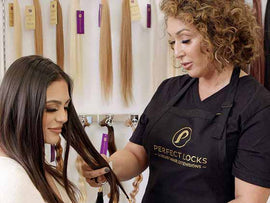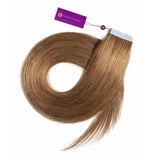Hair extensions have become an indispensable accessory for those seeking versatility in their hairstyles. Among the myriad installation methods, beaded installs and fusion installs have risen in popularity.
Beaded installs involve attaching hair extensions using small beads or loops that are clamped onto the natural hair. This method is known for being relatively quick and easy to apply, allowing for a seamless blend with natural hair. On the other hand, fusion installs use heat to bond the extensions to the natural hair. This method provides a more permanent solution, with extensions lasting several months.
Below is a detailed comparison of these two popular methods, addressing their suitability, installation processes, and essential considerations for hairdressers.
Beaded Installs
Beaded installs, also known as micro-link or micro-bead extensions, cater to a diverse clientele. They are particularly well-suited for individuals with medium to thick hair who look for a natural-looking enhancement. The great thing about this method is that it is versatile and accommodates various hair textures, from straight to wavy and curly.
Installation Process
The meticulous installation process of beaded installs begins with sectioning of the client's hair. Small sections of natural hair are then delicately threaded through tiny metal beads, acting as anchors for the extensions. These beads are securely clamped, providing a stable foundation for the subsequent attachment of the extensions. Typically crafted from high-quality human hair, these extensions are seamlessly integrated, ensuring a natural and polished appearance.
Maintenance and Pros
Beaded installs boast minimal damage to natural hair, as no heat or adhesives are involved in the installation process. This method offers ease of maintenance and removal, making it a convenient option for clients seeking flexibility in their hairstyle choices.
Drawbacks of Beaded Installs
It's essential to note that regular maintenance is crucial to secure the beads, and beaded installs might not be the best choice for individuals with fine or thin hair due to the weight of the beads.
Fusion Installs
Fusion installs, also known as keratin bond extensions, cater to those desiring a semi-permanent solution. Ideal for medium to thick hair, this method offers a long-lasting option without the need for frequent adjustments, making it suitable for clients with an active lifestyle.
Installation Process
Similar to beaded installs, fusion installs commence with the strategic sectioning of the client's natural hair. However, the key distinction lies in the preparation of the extensions. Small sections of the natural hair are treated with a keratin-based adhesive, and the extensions are then attached near the roots. The crucial bonding step involves the application of heat, melting the keratin bonds, and creating a durable connection with the natural hair.
Advantages of Fusion Installs
Fusion installs provide long-lasting results with reduced maintenance frequency. They offer versatility across various hair textures and lengths, making them a preferred choice for clients seeking a more enduring transformation. The secure bond formed during the installation process ensures the extensions can withstand diverse activities.
Challenges of Fusion Installs
On the flip side, the use of heat and adhesives in fusion installs can potentially cause damage to the natural hair. Additionally, the removal process can be time-consuming and may require the application of solvents, which requires careful consideration.
Making the Informed Choice
When deciding between beaded installs and fusion installs for hair extensions, consider the following:
- Hair type - Beaded installs are suitable for various hair types, including fine hair, as they use small beads to attach the extensions. On the other hand, fusion installs involve bonding extensions to your natural hair using heat and are generally better for thicker hair.
- Installation process - Beaded installs are often quicker and don't require heat during installation. Fusion installs may take longer as each extension is fused individually to your natural hair with a heating tool.
- Comfort - Beaded installs are usually considered more comfortable as they don't involve heat and allow for more natural movement of the hair. In contrast, fusion installs might feel slightly heavier initially and can be less flexible due to the bonded nature of the extensions.
- Maintenance - Beaded installs are often easier to maintain and remove, requiring less time and effort. Fusion installs might need more careful maintenance, and removal can be a bit more involved.
- Cost - Beaded installs are often more cost-effective since the installation process is generally quicker. Conversely, fusion installs can be pricier due to the time-consuming nature of the installation and the cost of the materials.
- Durability - Beaded installs may need more frequent adjustments as the beads can shift over time. In contrast, fusion installs are known for their durability as extensions stay in place for a longer period.
- Styling options - Beaded installs allow for more versatile styling since the beads are usually smaller and less noticeable. Fusion installs may limit certain styling options due to the bonded nature of the extensions.
Empowering Your Clients
As a trusted hairstylist, empowering your clients with knowledge about these installation methods fosters a collaborative decision-making process. Discussing the intricacies of beaded installs and fusion installs, along with their respective pros and cons, ensures that clients make choices aligned with their preferences and lifestyles.
Tailoring Recommendations
Your role extends beyond mere execution; you are a guide in the transformation of your clients. Consider factors such as hair texture, maintenance preferences, and the client's commitment to upkeep so you can tailor your recommendations effectively. A deep understanding of these installation methods positions you as a reliable source of guidance when it comes to hair extensions.
Addressing Concerns
Addressing potential concerns with each method is crucial to establishing trust with your clients. For beaded installs, emphasizing the need for regular maintenance and the potential unsuitability for fine or thin hair sets realistic expectations. When discussing fusion installs, transparency about the use of heat and adhesives and the careful removal process ensures clients are well-informed.
Final Thoughts
With regards to hair extensions, beaded installs and fusion installs continue to captivate clients who are looking for transformative hair solutions. By learning the difference between these two methods, hairdressers can confidently guide their clients toward choices that not only enhance their aesthetic appeal but also align with their lifestyle and preferences.
As a hair stylist armed with knowledge, your ability to provide personalized recommendations ensures that every client walks away not only with a stunning new look but also with the satisfaction of a well-informed and empowered choice.

















